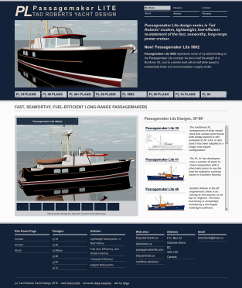Passagemaker Lite 39
PL 39 Stock Plans
Designed for cold-molded or aluminum construction
. Round bottom sheathed strip or cold-molded (3 layers) wood construction. Foam cored fiberglass construction option. Multi-chine aluminum plate constructionFull size plot files
for hull station molds, bulkheads, deck and house beams, stem, etc.CAD drawings
of general construction, construction sections, tanks, deckhouse, profile and arrangement, shaft and rudder plan.
Similar Designs
Design Reviews
- Design Review of Passagemaker Lite 39 in Wooden Boat Magazine, June 2012
- Wooden Boat, Issue 226, June 2012
-
A Study in Efficiency: Passagemaker Lite 39... A boat that will top out at a very respectable 12 knots and be able to cruise for almost a week at 9 knots. A 7-knot cruising speed will give you a limit of pretty close to 4,000 miles...At this rate you will burn a mere 0.9 gallon per hour, or 7.8 miles per gallon. Pretty good mileage considering you are bringing your home with you...And a pretty nice home too. For a live-aboard couple, it's hard to see how to improve it...
- Off the Drawing Board: Passagemaker Lite 46, 56, and 80 PDF
- Art Paine, Maine Boats and Harbors, Issue 76, Autumn 2003
-
There is nothing new to the idea of thin, light, seaworthy, and fast powerboats, and Tad Roberts has been inspired by several of those of the past. To Roberts, these boats brought to mind a glaring question: Why didn't the whole world flock to these sensible and efficient pleasure powerboat designs? He answered that question by identifying the elements that limited the type, and, in his Lite designs, addressed them. All in all, the Passagemaker Lite series is masterful work.
Read articles by Tad Roberts about Passagemaker Lite:
-
“Passagemaker Lite” (Professional Boatbuilder) PDF
“Passagemaker Lite: A Modern Lightweight Restatement of the Lean Long-range Power Cruiser ”
Professional BoatbuilderNumber 81, Feb/March 2003 -
“Passagemaker Lite” (Passagemaker) PDF
“Passagemaker Lite: A Modern Lightweight Restatement of the Lean Long-range Power Cruiser”
Passagemaker Magazine 2003 -
“ A Brief History of Lightweight Motor Yachts ” (Passagemaker) PDF,
“A Brief History of Lightweight Motor Yachts ” Passagemaker Magazine2003
Designer's Comments
The PL 39 was created at the request of a client for something more modest than my larger PL 46 and 56. This client already owned a single large diesel and so we deviated from the original twin engine aft formula which worked well in the larger boats.
In these boats the fuel load is the largest single weight and the entire design revolves around the amidships placement of that. So the layout stemmed from the fuel tank placement under the pilothouse with main engine aft of the tanks in the galley area. While this arrangement lacks an obvious engineroom (main engine being installed in a box in the galley) there is a large “pump room” under the pilothouse forward of the fuel tanks. The starting battery is alongside the engine and the house battery bank is aft on centerline under the settee. Water tanks are under the aft cockpit.
I choose the raised deck for a number of reasons; strength, simple construction, maximum interior volume, and a high angle of vanishing stability. With these high topsides maximum righting arm is well above 45 degrees. The downside of lighter boats at sea is quicker motion, roll period for the PL type is around 2.5 seconds, this takes some getting used to. To alleviate this quick motion I’ve reduced heights above the roll center (approximately DWL) and placed the main cabin sole below the waterline. Like a sailboat when it’s really rough the most comfortable spot will be on the cabin sole.
In my opinion the strongest, stiffest, and fastest (least man hours) construction method for these boats is sheathed strips over NC cut plywood or particle board molds. All longitudinals are laminated Douglass Fir and deck and house are plywood over foam cores.
In looking at this arrangement 9 years after first drawing it, I see some alternatives. One thing we found in the main cabin of the PL46 is that any division really affects visual space. Thus I would move the head out of the aft cabin and place it right forward in the least used part of the boat. Aft of the head I would place a double and a single berth (P&S) with their feet under the pilothouse sole. Then I would move the galley to the port side of the engine box and create a U shaped counter area accessed from aft. This takes the galley out of the main passageway and allows large pantry and storage areas to starboard where the galley is now. Living aboard full time makes one realize just how important large lockers are, you can’t have too many.
The remainder of the boat would stay the same except I would add more ventilators and raise hatches off the deck surface for better ventilation and keeping water out. Also I would absolutely include a sailing rig with jib and (reefing) mainsail. I am amazed at the reasonable progress possible under a very short rig with just minimal keel. This could be a huge benefit over a season's cruising.


